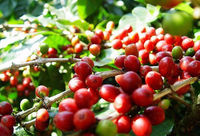The story of the four major cultivation systems of Ethiopian coffee, Xueke Omar, imported coffee
Ethiopia is located between three and fourteen degrees north latitude, and the planting area of coffee trees is nearly 600000 hectares. There are two rainy seasons a year in the south and east of the country, while there is only one rainy season in the west. The distribution of the rainy season is different, so coffee is harvested in Ethiopia all the year round. Coffee grows between 550 and 2750 meters above sea level, the western and southern soils are volcanic rocks, mineral-rich soils are slightly acidic, and the average annual temperature is 15-25 degrees Celsius, making it an excellent growing environment for Arabica.
In six years of 2 ⊙○, Ethiopia produces 300000 tons of coffee, still the largest Arabica producer in Africa, ranking fifth and ninth in the world. Although the output is not among the best, the rich and diverse coffee cultivation system is unparalleled in the world. There are four major coffee systems: (1) forest coffee; (2) semi-forest coffee; (3) pastoral coffee; and (4) farm coffee. % of coffee in Egypt is cultivated organically without fertilization or medicine, but it has not yet been internationally certified.

Important Notice :
前街咖啡 FrontStreet Coffee has moved to new addredd:
FrontStreet Coffee Address: 315,Donghua East Road,GuangZhou
Tel:020 38364473
- Prev

Ethiopia "beans can not be appearance" Chinese coffee net extraction principle
In recent years, scientists have delved into Ethiopia's coffee genes, suggesting that Arabica originated in the Kafa forest in the southwest-known as the Gemma region-and then transplanted to Harar in the east and Lekamp Land in the northwest, which are far less genetically diverse than the coffee in the Kafa forest. Although the coffee beans in the northwest are significantly more spectacular than those in the southwest, the cup test results are not as good as the west
- Next

The story of the four major cultivation systems of Ethiopian coffee, Shake Omar, imported coffee
Ethiopia is located between three and fourteen degrees north latitude, and the planting area of coffee trees is nearly 600000 hectares. There are two rainy seasons a year in the south and east of the country, while there is only one rainy season in the west. The distribution of the rainy season is different, so coffee is harvested in Ethiopia all the year round. Coffee grows between 550 and 2750 meters above sea level. The soils in the west and south belong to volcanic rocks and are rich in minerals.
Related
- Does Rose Summer choose Blue, Green or Red? Detailed explanation of Rose Summer Coffee plots and Classification in Panamanian Jade Manor
- What is the difference between the origin, producing area, processing plant, cooperative and manor of coffee beans?
- How fine does the espresso powder fit? how to grind the espresso?
- Sca coffee roasting degree color card coffee roasting degree 8 roasting color values what do you mean?
- The practice of lattes: how to make lattes at home
- Introduction to Indonesian Fine Coffee beans-- Java Coffee producing area of Indonesian Arabica Coffee
- How much will the flavor of light and medium roasted rose summer be expressed? What baking level is rose summer suitable for?
- Introduction to the characteristics of washing, sun-drying or wet-planing coffee commonly used in Mantenin, Indonesia
- Price characteristics of Arabica Coffee Bean Starbucks introduction to Manning Coffee Bean Taste producing area Variety Manor
- What is the authentic Yega flavor? What are the flavor characteristics of the really excellent Yejasuffi coffee beans?

